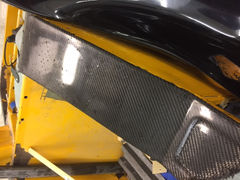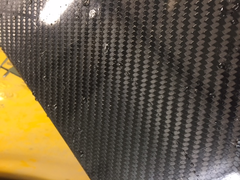
Compressor has died - any suggestions?
FuryRebuild - 8/10/14 at 07:05 PM
Dear All
I have a Clarke Raider 100 V-Twin compressor which I
bought second hand a year ago, and has been brilliant for me.
Tonight when I turned it on, it made a strangulated ooo sound for a second and blew the fuse.
I replaced the fuse and it blew it again. Looking at it, it may have been spitting oil out and the oil level looked low, so I topped it up and tried
again. ooo sound. Blown fuse. I've stopped.
This has never missed a beat before and I'll be lost without it.
Any suggestions as to what has gone wrong?
Thanks
Mark
coozer - 8/10/14 at 07:13 PM
Is the compressor shell turning OK with the belt off, or is it direct drive?
blakep82 - 8/10/14 at 07:30 PM
I think clarke/machine mart sell everything for them, so belt off (if belt driven) see if everything turns free. If anythings siezed (motor bearings
or air pump if the oils gone) then you should be able to buy replacements.
Might be fairly expensive, but cheaper than a new compressor
Eg https://www.machinemart.co.uk/shop/product/details/clarke-ce30-3hp-v-twin-direct-drive-air-comp
If its making an electrical hum noise, I'd say the air pump has siezed
[Edited on 8/10/14 by blakep82]
SCAR - 8/10/14 at 07:41 PM
There will be at least one, possibly two capacitors wired into the motor. The run capacitor is needed for the motor to run and if fitted the start
capacitor helps the motor start. One of these is the most likely culprit. Replacing them is cheap and easy and a basic check can be made with a
multimeter. I've just repaired my 3 hp Clarke compressor by replacing the run capacitor bought off ebay for £10.50 inc posting. Make sure you get
a 440v rated one for longer life (on 240v supply) and match the uf value exactly. If you have two the start capacitor is the one that has a mechanical
or electronic switch that removes it from the circuit soon after the motor starts up. Failure of either will cause the motor to stall on start up
drawing too much current resulting in a blown fuse. Run and start capacitors are manufactured differently although they may have the same ratings,
you need to specify the purpose when buying. It is very common for these motors to be replaced at £150 when the problem is just a £10.50 capacitor.
Just to be sure its the motor that's the problem and not the compressor try the motor with no load. i.e. take the drive belt off
[Edited on 8/10/14 by SCAR]
daviep - 8/10/14 at 07:45 PM
Unloader valve not unloading the pump and the motor is unable to start under load.
There is a small rubber diaphragm or dart which is a check valve, normally fitted directly on to the tank and the delivery pipe from the compressor
connects to it. These often fail and cause the motor to try and start under load, often you can turn the ruber dart or diaphragm over if one sealing
surface is damaged.
Cheers
Davie
FuryRebuild - 8/10/14 at 08:04 PM
Thanks Everyone
Loads to think about, especially getting it out from under the bench and cupboards in which I encased it.
adithorp - 8/10/14 at 08:13 PM
quote:
Originally posted by SCAR
There will be at least one, possibly two capacitors wired into the motor. The run capacitor is needed for the motor to run and if fitted the start
capacitor helps the motor start. One of these is the most likely culprit. Replacing them is cheap and easy and a basic check can be made with a
multimeter. I've just repaired my 3 hp Clarke compressor by replacing the run capacitor bought off ebay for £10.50 inc posting. Make sure you get
a 440v rated one for longer life (on 240v supply) and match the uf value exactly. If you have two the start capacitor is the one that has a mechanical
or electronic switch that removes it from the circuit soon after the motor starts up. Failure of either will cause the motor to stall on start up
drawing too much current resulting in a blown fuse. Run and start capacitors are manufactured differently although they may have the same ratings,
you need to specify the purpose when buying. It is very common for these motors to be replaced at £150 when the problem is just a £10.50 capacitor.
Just to be sure its the motor that's the problem and not the compressor try the motor with no load. i.e. take the drive belt off
[Edited on 8/10/14 by SCAR]
That'd be my guess. Ours went once and had how to test it described to me, then I took the cover off and the capacitor had a big, burned hole in
it; No testing needed 
SCAR - 8/10/14 at 08:20 PM
It makes it easy if the fault is visible but unfortunately its not always the case, my dodgy cap showed no external signs at all.
big_wasa - 8/10/14 at 09:53 PM
Ive had a compressor do this and it was the start/run cap mine had spilled its guts every ware.
FuryRebuild - 9/10/14 at 10:11 AM
adithorp - what should I be looking for on the multitester?
Thanks
Mark
quote:
Originally posted by adithorp
quote:
Originally posted by SCAR
There will be at least one, possibly two capacitors wired into the motor. The run capacitor is needed for the motor to run and if fitted the start
capacitor helps the motor start. One of these is the most likely culprit. Replacing them is cheap and easy and a basic check can be made with a
multimeter. I've just repaired my 3 hp Clarke compressor by replacing the run capacitor bought off ebay for £10.50 inc posting. Make sure you get
a 440v rated one for longer life (on 240v supply) and match the uf value exactly. If you have two the start capacitor is the one that has a mechanical
or electronic switch that removes it from the circuit soon after the motor starts up. Failure of either will cause the motor to stall on start up
drawing too much current resulting in a blown fuse. Run and start capacitors are manufactured differently although they may have the same ratings,
you need to specify the purpose when buying. It is very common for these motors to be replaced at £150 when the problem is just a £10.50 capacitor.
Just to be sure its the motor that's the problem and not the compressor try the motor with no load. i.e. take the drive belt off
[Edited on 8/10/14 by SCAR]
That'd be my guess. Ours went once and had how to test it described to me, then I took the cover off and the capacitor had a big, burned hole in
it; No testing needed 
dhutch - 9/10/14 at 11:57 AM
You can test the unloaded valve fault by draining down the tank, although my 12yo 1.5hp belt drive clarke will start without it.
Cap sounds likely. Worst case the oils got too low and its internally eaten itself, but given it was a start up fault I would look elsewhere first.
The Raidar in the link appears to be one of the newer design direct-drive units.
Daniel
SCAR - 9/10/14 at 11:58 AM
Disconnect the cap from the circuit and test for resistance, you should get a reading that quickly settles to 1
Whilst doing this the battery in the multimeter is actually applying a current and charging up the capacitor.
Change to DC voltage and reconnect the meter and check the cap again. You should see a voltage reading that gradually reduces as the cap
discharges.
If yours doesn't do this it needs replacing.
Have you found if you have just a run capacitor or run and start capacitors and their uf values? Hopefully these will be shown on the capacitor case
as you can't establish uf without a capacitor meter. The above check just indicates whether they are working or not.
Be careful caps can hold a charge for quite a while and shock. I always start and finish by making sure they are discharged by briefly shorting across
the terminals and if you want to repeat the multimeter test discharge first.
THIS IS ONLY LAYMANS ADVICE I WOULD POINT OUT I AM NOT A QUALIFIED ELECTRICIAN
FuryRebuild - 9/10/14 at 12:03 PM
Yup. Mine is direct drive
quote:
Originally posted by dhutch
You can test the unloaded valve fault by draining down the tank, although my 12yo 1.5hp belt drive clarke will start without it.
Cap sounds likely. Worst case the oils got too low and its internally eaten itself, but given it was a start up fault I would look elsewhere first.
The Raidar in the link appears to be one of the newer design direct-drive units.
Daniel
FuryRebuild - 13/10/14 at 07:35 AM
Update - I've tested both capacitors according to SCAR's method. Both are healthy. I've found the dart-valve thingy, and that pulls in
and out and feels like it's got some spring in it. I've not removed it and fiddled with it.
It looks like I'm in for a new motor unit - sigh, £180 after VAT.
SCAR - 13/10/14 at 07:41 AM
Machine mart have vat free days on Sunday 19th Oct and Sunday 26th Oct You need to register with them for an invitation
Make sure the motor still refuses to run with no load before buying a new one, it could still be the pump that's seized
[Edited on 13/10/14 by SCAR]
FuryRebuild - 15/10/14 at 03:03 PM
I've tested it with Machine Mart, and the fan is siezed. This means the unit is knackered. The motor and pump can be split and their engineer
will be on site on Wednesday offering to fix it (£24 for half an hour, including diagnosis and time to fix) but there's no guarantee it still
won't be a replacement unit.
However, as thanks for all your help, I've included a picture of the top of the carbon transmission tunnel that I was wanting to make - this was
a failed resin infusion (details here) but I thought I'd share anyway.
This is the top part only, and non structural (yet)


Description
And here is a close-up of the CF, with a decent surface finish - excuse the raindrops.


Description
quote:
Originally posted by SCAR
Machine mart have vat free days on Sunday 19th Oct and Sunday 26th Oct You need to register with them for an invitation
Make sure the motor still refuses to run with no load before buying a new one, it could still be the pump that's seized
[Edited on 13/10/14 by SCAR]

